英美诗歌鉴赏——tohelen,致海伦
- 格式:doc
- 大小:23.00 KB
- 文档页数:3
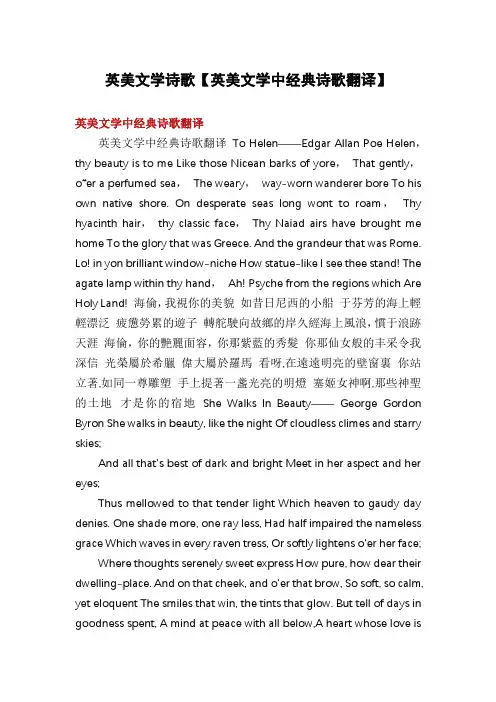
英美文学诗歌【英美文学中经典诗歌翻译】英美文学中经典诗歌翻译英美文学中经典诗歌翻译To Helen——Edgar Allan Poe Helen,thy beauty is to me Like those Nicean barks of yore,That gently,o“er a perfumed sea,The weary,way-worn wanderer bore To his own native shore. On desperate seas long wont to roam,Thy hyacinth hair,thy classic face,Thy Naiad airs have brought me home To the glory that was Greece. And the grandeur that was Rome. Lo! in yon brilliant window-niche How statue-like I see thee stand! The agate lamp within thy hand,Ah! Psyche from the regions which Are Holy Land! 海倫,我視你的美貌如昔日尼西的小船于芬芳的海上輕輕漂泛疲憊勞累的遊子轉舵駛向故鄉的岸久經海上風浪,慣于浪跡天涯海倫,你的艷麗面容,你那紫藍的秀髮你那仙女般的丰采令我深信光榮屬於希臘偉大屬於羅馬看呀,在遠遠明亮的壁窗裏你站立著,如同一尊雕塑手上提著一盞光亮的明燈塞姬女神啊,那些神聖的土地才是你的宿地She Walks In Beauty——George Gordon Byron She walks in beauty, like the night Of cloudless climes and starry skies;And all that’s best of dark and bright Meet in her aspect and her eyes;Thus mellowed to that tender light Which heaven to gaudy day denies. One shade more, one ray less, Had half impaired the nameless grace Which waves i n every raven tress, Or softly lightens o’er her face;Where thoughts serenely sweet express How pure, how dear their dwelling-place. And on that cheek, and o’er that brow, So soft, so calm, yet eloquent The smiles that win, the tints that glow. But tell of days in goodness spent, A mind at peace with all below,A heart whose love isinnocent! 她在美中徜徉,她在美中穿行;象深邃的苍穹缀满繁星,象皎洁的夜空万里无云。
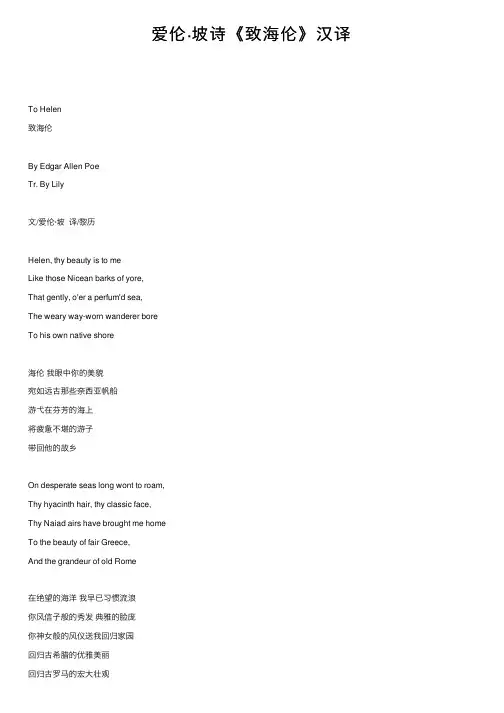
爱伦·坡诗《致海伦》汉译To Helen致海伦By Edgar Allen PoeTr. By Lily⽂/爱伦·坡译/黎历Helen, thy beauty is to meLike those Nicean barks of yore,That gently, o'er a perfum'd sea,The weary way-worn wanderer boreTo his own native shore海伦我眼中你的美貌宛如远古那些奈西亚帆船游⼷在芬芳的海上将疲惫不堪的游⼦带回他的故乡On desperate seas long wont to roam,Thy hyacinth hair, thy classic face,Thy Naiad airs have brought me homeTo the beauty of fair Greece,And the grandeur of old Rome在绝望的海洋我早已习惯流浪你风信⼦般的秀发典雅的脸庞你神⼥般的风仪送我回归家园回归古希腊的优雅美丽回归古罗马的宏⼤壮观Lo! in that little window-niche How statue-like I see thee stand! The folded scroll within thy hand —A Psyche from the regions which Are Holy land!看在那狭⼩的窗龛⾥你犹如⼀座伫⽴的雕塑⼿握书卷啊⼀位来⾃圣地的希腊⼥神!译于2018年3⽉3⽇星期六。
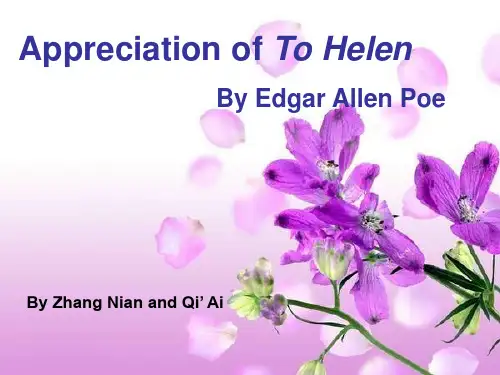
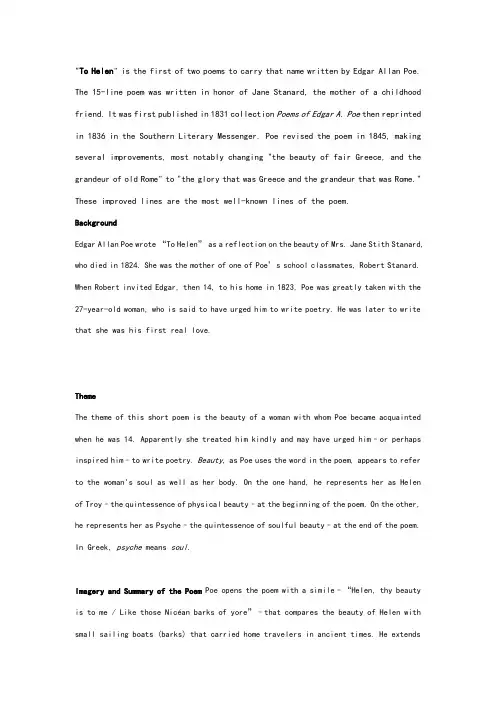
"To Helen" is the first of two poems to carry that name written by Edgar Allan Poe. The 15-line poem was written in honor of Jane Stanard, the mother of a childhood friend. It was first published in 1831 collection Poems of Edgar A. Poe then reprinted in 1836 in the Southern Literary Messenger. Poe revised the poem in 1845, making several improvements, most notably changing "the beauty of fair Greece, and the grandeur of old Rome" to "the glory that was Greece and the grandeur that was Rome." These improved lines are the most well-known lines of the poem.BackgroundEdgar Allan Poe wrote “To Helen” as a reflection on the beauty of Mrs. Jane Stith Stanard, who died in 1824. She was the mother of one of Poe’s school classmates, Robert Stanard. When Robert invited Edgar, then 14, to his home in 1823, Poe was greatly taken with the 27-year-old woman, who is said to have urged him to write poetry. He was later to write that she was his first real love.ThemeThe theme of this short poem is the beauty of a woman with whom Poe became acquainted when he was 14. Apparently she treated him kindly and may have urged him–or perhaps inspired him–to write poetry. Beauty, as Poe uses the word in the poem, appears to refer to the woman's soul as well as her body. On the one hand, he represents her as Helen of Troy–the quintessence of physical beauty–at the beginning of the poem. On the other, he represents her as Psyche–the quintessence of soulful beauty–at the end of the poem. In Greek, psyche means soul.Imagery and Summary of the Poem Poe opens the poem with a simile–“Helen, thy beauty is to me / Like those Nicéan barks of yore”–that compares the beauty of Helen with small sailing boats (barks) that carried home travelers in ancient times. He extendsthis boat imagery into the second stanza, when he says Helen brought him home to the shores of the greatest civilizations of antiquity, classical Greece and Rome. It may well have been that Mrs. Stanard’s beauty and other admirable qualities, as well as her taking notice of Poe’s writing ability, helped inspire him to write poetry that mimicked in some ways the classical tradition of Greece and Rome. Certainly the poem’s allusions to mythology and the classical age suggest that he had a grounding in, and a fondness for, ancient history and literature. In the final stanza of the poem, Poe imagines that Mrs. Stanard (Helen) standing before him in a recess or alcove in front of a window. She is holding an agate lamp, as the beautiful Psyche did when she discovered the identity of Eros (Cupid). For further information on the agate lamp, Psyche, and Eros, sees the comments opposite the third stanza.Analysis:As is typical with many of Poe's poems, the rhythm and rhyme scheme of "To Helen" is irregular but musical in sound. The poem consists of three stanzas of five lines each, where the end rhyme of the first stanza is ABABB, that of the second is ABABA, and that of the third is ABBAB. Poe uses soothing, positive words and rhythms to create a fitting tone and atmosphere for the poem. His concluding image is that of light, with a "brilliant window niche" and the agate lamp suggesting the glowing of the "Holy Land," for which Helen is the beacon."To Helen" is the first of two poems to carry that name written by Poe. The 15-line poem was written in honor of Jane Stanard, the mother of a childhood friend.. It was firstpublished in 1831 collection Poems of Edgar A. Poe then reprinted in 1836 in the Southern Literary Messenger. Poe revised the poem in 1845, making several improvements, most notably changing "the beauty of fair Greece, and the grandeur of old Rome" to "the glory that was Greece and the grandeur that was Rome." These improved lines are the most well-known lines of the poem.Imagery and Summary of the PoemPoe opens the poem with a simile–“Helen, thy beauty is to me / Like those Nicéan barks of yore”–that compares the beauty of Helen with small sailing boats that carried home travelers in ancient times. He extends this boat imagery into the second stanza, when he says Helen brought him home to the shores of the greatest civilizations of antiquity, classical Greece and Rome. It may well have been that Mrs. Stanard’s beauty and other admirable qualities, as well as her taking notice of Poe’s writing ability, helped inspire him to write poetry that mimicked in some ways the classical tradition of Greece and Rome. Certainly the poem’s allusions to mythology and the classical age suggest that he had a grounding in, and a fondness for, ancient history and literature. In the final stanza of the poem, Poe imagines that Mrs. Stanard (Helen) is standing before him in a recess or alcove in front of a window. She is holding an agate lamp, as the beautiful Psyche did when she discovered the identity of Eros (Cupid). For further information on the agate lamp, Psyche, and Eros, see the comments opposite the third stanza.The ThemeThe beauty of a woman with whom Poe became acquainted when he was she treated him kindly and may have urged him or perhaps inspired him to write poetry.Beauty,as Poe uses the word in thepoem ,appears to refer to the woman’s body as well as her soul.On the one hand ,he represents her as Helen of Troy—the quintessence(典范)of physical beauty-at the beginning of this poem.On the other ,her represents her as Psyche –at the end of the Greek,Psyche means soul.Stanza 1The poet first mentioned Helen, the most famous beauty in Great mythology. Then Poe compared himself to Odysseus, who wandered for ten years over the sea to get home. As Odysseus, Edgar Allan Poe was persistent in his chasing after fine arts with the sincere belief that art, or beauty and truth, is the ultimate aim, the home, for the wandering poet; while Helen, the embodiment of ancient beauty, is the guider to that dreamland 诗人第一次提到海伦,最著名的风景就像是伟大神话。
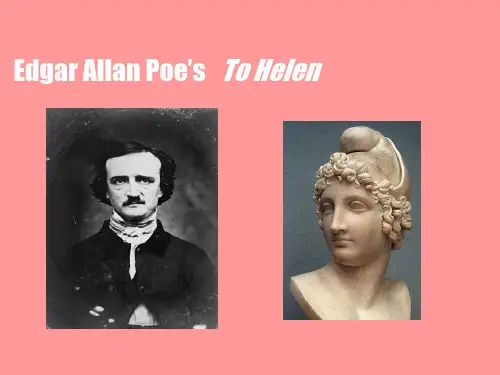
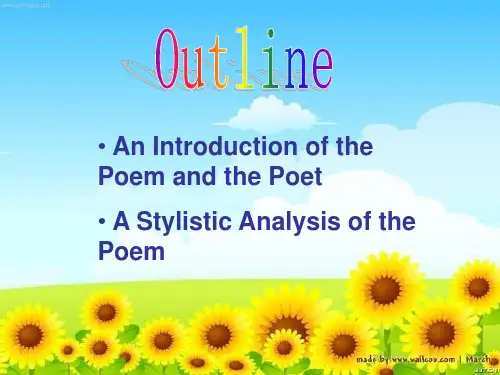

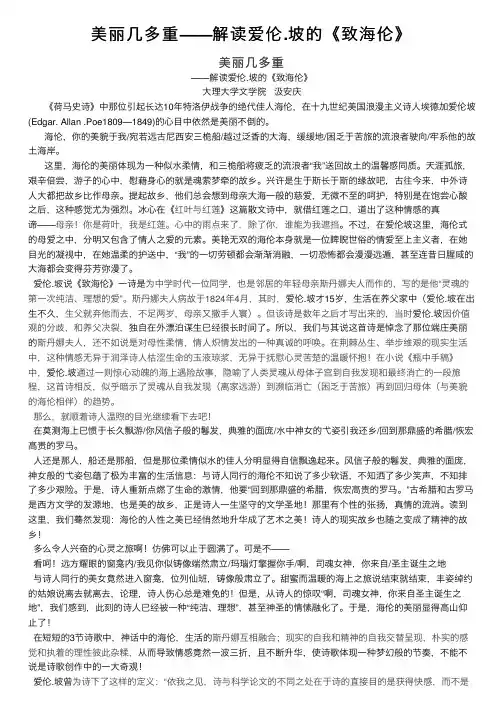
美丽⼏多重——解读爱伦.坡的《致海伦》美丽⼏多重——解读爱伦.坡的《致海伦》⼤理⼤学⽂学院汲安庆《荷马史诗》中那位引起长达10年特洛伊战争的绝代佳⼈海伦,在⼗九世纪美国浪漫主义诗⼈埃德加爱伦坡(Edgar. Allan .Poe1809—1849)的⼼⽬中依然是美丽不倒的。
海伦,你的美貌于我/宛若远古尼西安三桅船/越过泛⾹的⼤海,缓缓地/困乏于苦旅的流浪者驶向/牢系他的故⼟海岸。
这⾥,海伦的美丽体现为⼀种似⽔柔情,和三桅船将疲乏的流浪者“我”送回故⼟的温馨感同质。
天涯孤旅,艰⾟倍尝,游⼦的⼼中,慰藉⾝⼼的就是魂萦梦牵的故乡。
兴许是⽣于斯长于斯的缘故吧,古往今来,中外诗⼈⼤都把故乡⽐作母亲。
提起故乡,他们总会想到母亲⼤海⼀般的慈爱,⽆微不⾄的呵护,特别是在饱尝⼼酸之后,这种感觉尤为强烈。
冰⼼在《红叶与红莲》这篇散⽂诗中,就借红莲之⼝,道出了这种情感的真谛——母亲!你是荷叶,我是红莲。
⼼中的⾬点来了,除了你,谁能为我遮挡。
不过,在爱伦坡这⾥,海伦式的母爱之中,分明⼜包含了情⼈之爱的元素。
美艳⽆双的海伦本⾝就是⼀位睥睨世俗的情爱⾄上主义者,在她⽬光的凝视中,在她温柔的护送中,“我”的⼀切劳顿都会渐渐消融,⼀切恐怖都会漫漫远遁,甚⾄连昔⽇腥咸的⼤海都会变得芬芳弥漫了。
爱伦.坡说《致海伦》⼀诗是为中学时代⼀位同学,也是邻居的年轻母亲斯丹娜夫⼈⽽作的,写的是他“灵魂的第⼀次纯洁、理想的爱”。
斯丹娜夫⼈病故于1824年4⽉,其时,爱伦.坡才15岁,⽣活在养⽗家中(爱伦.坡在出⽣不久,⽣⽗就弃他⽽去,不⾜两岁,母亲⼜撒⼿⼈寰)。
但该诗是数年之后才写出来的,当时爱伦.坡因价值观的分歧,和养⽗决裂,独⾃在外漂泊谋⽣已经很长时间了。
所以,我们与其说这⾸诗是悼念了那位端庄美丽的斯丹娜夫⼈,还不如说是对母性柔情,情⼈炽情发出的⼀种真诚的呼唤。
在荆棘丛⽣、举步维艰的现实⽣活中,这种情感⽆异于润泽诗⼈枯涩⽣命的⽟液琼浆,⽆异于抚慰⼼灵苦楚的温暖怀抱!在⼩说《瓶中⼿稿》中,爱伦.坡通过⼀则惊⼼动魄的海上遇险故事,隐喻了⼈类灵魂从母体⼦宫到⾃我发现和最终消亡的⼀段旅程,这⾸诗相反,似乎暗⽰了灵魂从⾃我发现(离家远游)到濒临消亡(困乏于苦旅)再到回归母体(与美貌的海伦相伴)的趋势。

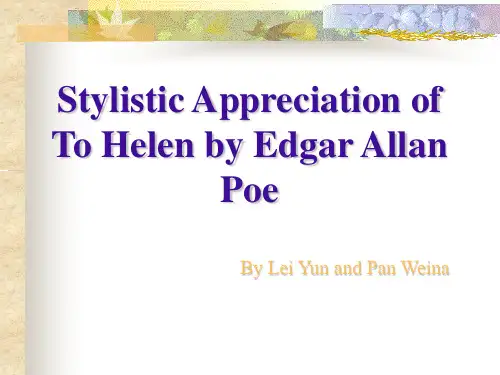
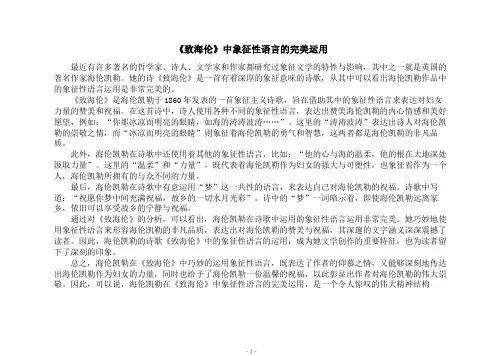
《致海伦》中象征性语言的完美运用最近有许多著名的哲学家、诗人、文学家和作家都研究过象征文学的特性与影响,其中之一就是英国的著名作家海伦凯勒。
她的诗《致海伦》是一首有着深厚的象征意味的诗歌,从其中可以看出海伦凯勒作品中的象征性语言运用是非常完美的。
《致海伦》是海伦凯勒于1860年发表的一首象征主义诗歌,旨在借助其中的象征性语言来表达对妇女力量的赞美和祝福。
在这首诗中,诗人使用各种不同的象征性语言,表达出赞美海伦凯勒的内心情感和美好愿望,例如:“你那冰凉而明亮的眼睛,如海的涛涛波涛……”。
这里的“涛涛波涛”表达出诗人对海伦凯勒的崇敬之情,而“冰凉而明亮的眼睛”则象征着海伦凯勒的勇气和智慧,这两者都是海伦凯勒的非凡品质。
此外,海伦凯勒在诗歌中还使用着其他的象征性语言,比如:“他的心与海的温柔,他的根在大地深处汲取力量”。
这里的“温柔”和“力量”,既代表着海伦凯勒作为妇女的强大与可塑性,也象征着作为一个人,海伦凯勒所拥有的与众不同的力量。
最后,海伦凯勒在诗歌中有意运用“梦”这一共性的语言,来表达自己对海伦凯勒的祝福。
诗歌中写道:“祝愿你梦中间充满祝福,故乡的一切水月光彩”。
诗中的“梦”一词暗示着,即使海伦凯勒远离家乡,依旧可以享受故乡的宁静与祝福。
通过对《致海伦》的分析,可以看出,海伦凯勒在诗歌中运用的象征性语言运用非常完美。
她巧妙地使用象征性语言来形容海伦凯勒的非凡品质,表达出对海伦凯勒的赞美与祝福,其深邃的文字涵义深深震撼了读者。
因此,海伦凯勒的诗歌《致海伦》中的象征性语言的运用,成为她文学创作的重要特征,也为读者留下了深刻的印象。
总之,海伦凯勒在《致海伦》中巧妙的运用象征性语言,既表达了作者的仰慕之情,又能够深刻地传达出海伦凯勒作为妇女的力量,同时也给予了海伦凯勒一份温馨的祝福,以此彰显出作者对海伦凯勒的伟大崇敬。
因此,可以说,海伦凯勒在《致海伦》中象征性语言的完美运用,是一个令人惊叹的伟大精神结构- 1 -。
tohelen体现的结构美
"To Helen"是爱伦·坡写的一首诗,主要描写了诗人对一位叫做海伦(Helen)的女性的崇拜和追求。
这首诗体现出了诗歌结构美的几个特点:
1. 韵律优美:它采用了一种比较古典的诗体——希腊十四行诗(Petrarchan sonnet),每个部分用相同的韵脚连接起来,使整首诗具有一种和谐的韵律。
2. 分段清晰:整首诗由两部分构成,前八行是描述诗人对海伦美貌的赞美,后六行则是诗人对海伦的期望与追求。
这种明确的段落划分有助于读者更好地理解诗歌的意义。
3. 意象生动:诗人使用了许多具体的比喻和意象,使抽象的情感和思想变得更加生动形象。
比如海伦的美貌被比喻成“吉普赛人的夜晚天空”、“船的舷窗上微弱的火光”,使读者能够感受到诗人对海伦的强烈感情。
这些因素共同营造了"To Helen"这首诗中的结构美,使其成为一篇经典的爱情诗歌。
to helen修辞手法
《to helen》中使用了大量的明喻和暗喻手法,例如将海伦比作“百合花”、“珊瑚”等,使诗歌更加形象生动。
同时,诗人还运用了对偶、排比等修辞手法,使诗歌在形式上更加优美整齐,同时增强了诗歌的节奏感和韵律感。
除了明喻和暗喻之外,《to helen》中还使用了其他修辞手法,例如:
1.拟人:诗中使用了拟人的修辞手法,将海伦比作“悲哀的维
纳斯”,强调了她的美丽和不幸。
2.排比:诗中出现了多处排比句,例如“more fair than fair, more
wise than wise, more strong than strong, had been the children of her mind”,这种修辞手法使诗歌更加有气势,增强了诗歌的表现力。
3.反复:诗中出现了多次重复的词语和句子,例如“more fair
than fair, more wise than wise”,这种修辞手法强调了诗人对海伦的赞美之情。
4.对比:诗中将海伦的美貌与不幸进行了对比,突出了她的不
幸和痛苦。
5.夸张:诗中使用了夸张的修辞手法,例如“the children of her
mind had grown to be the wonder of the world”,这种修辞手法强调了诗人对海伦的赞美之情。
这些修辞手法,使诗歌更加富有表现力、艺术价值。
Helen,thy beauty is to me
Like those Nicèan barks of yore
That gently, o'er a perfumed sea, The weary way-worn wanderer bore To his own native shore.
On desperate seas long wont to roam, Thy hyacinth hair, thy classic face, Thy Naiad airs have brought me home To the glory that was Greece,
And the grandeur that was Rome. Lo, in yon brilliant window-niche How statue-like I see thee stand,
The agate lamp within thy hand,
Ah! Psyche, from the regions which Are holy land!
翻译:
致海伦
爱伦坡
海伦哦,我眼⾥你的美丽
就像昔⽇尼西亚的⼩船,
轻柔地在飘⾹的海⾯,
将那旅途劳顿的游⼦
带回他故乡的海岸。
在绝望的海⾯、亘古波涛⽆边,
你飘飘的秀发,你典雅的脸庞,
你⽔中仙⼥般的丰姿让我想见
希腊的荣光、
罗马的庄严。
看哦!在远⽅的华丽窗龛,
我见你如雕像⽟⽴,
⼿⾥擎着玛瑙灯盏!
啊,灵魂之⼥,你来⾃哪⾥,
哪⾥就是圣地!。
英美诗歌鉴赏——
To Helen,致海伦
To Helen
Helen, thy beauty is to me
Like those Nicean barks1 of yore,2
That gently, o'er a perfumed3 sea,
The weary4, wayworn5 wanderer6 bore
To his own native shore.
On desperate seas long wont to roam7,
Thy hyacinth hair, thy classic face,
Thy Naiad airs have brought me home
To the glory that was Greece
And the grandeur 8that was Rome.
Lo! in yon brilliant window-niche9
How statue-like10 I see thee stand,
1
平底船
2
很久以前
3
芳香的
4
疲倦的
5
旅行累了的
6
漫游者,旅行者
7
漫步,漫游
8
壮丽,宏伟
9
壁龛
10
向雕像一样
The agate11 lamp within thy hand!
Ah, Psyche, from the regions which
Are Holy Land!
The writer Edgar Allen Poe was born in 1809. His father deserted the
family, and his mother died when Poe was three. Poe was taken into the
home of his uncle. In 1826, he entered the University of Virginia, only
to drop out later . He was sent to West Point and dismissed, too. Then
he turned to fiction writing to support himself. He worked as an editor
throughout his life. His wife’s death in 1847, drove Poe to heavy drinking
occasionally. One day in 1849, he was found unconscious on a Baltimore
street and then died.
Poe established himself as a successful short story writer and
literary critic. He succeeded in formulating influential literary
theories and in demonstrating mastery of the forms he favored_hinghly
musical poems and short prose narratives. His theory of short fiction is
best exemplified in Ligeia and The Fall of The House of Usher, which was
to become one of his most famous stories.
Poe wrote To Helen as a reflection on the beauty of who died in 1824.
She encouraged Poe to write poems when he was 14. Poe regarded her as his
first , pure love.
First, let us see the clever rhymes in this great poem. Alliteration:
the /w/ in “ The weary, wayworn wanderer bore” and the /s/ in “ How
statue-like I see thee stand” .assonance: both “like” and “Nicean”
have the vowel /ai/; both “wont” and “roam” have the vowel /
/ ; “agate”,“lamp” and“hand”all have the vowel / /. Rhyme: “me”
and “sea”; ”yore”, ”bore” and “shore”; “roam”, “home” and
“Rome”. The rhymes makes the poem contain musical charm and more
attractive to read.
The title expressed how beautiful was by just one word—Helen,who,
in Greek story, was the most beautiful woman in the world and also lighted
the flames of the Trojan war.But that is not enough, we see the poet used
similes to continue his praise. He compared her to “Nicean barks of
yore”which brought tired “wanderers” home. The /w/ in “ The weary,
wayworn wanderer bore” bring out the tired faces vividly. The lady are
not doll, she could brought peace and relief. Maybe that is how the writer
thought about .
In the second part, the poet described just two body parts, “Thy
hyacinth hair, thy classic face,” short but vivid, just let the reader
imagine the picture of a beauty who is classic just like the goddess in
the Greek story. The word “Greece” and “Rome” were mentioned in this
11
玛瑙的
part, we know Greece and Rome are two ideal places in the heart of western
people. I think that addes to the woman’s classic beauty again.
In the third part, there is another simile, “How statue-like I see
thee stand,” the woman is just like a statue which will never become old
or ugly and will remain forever. “Psyche”means soul in Greek, so in this
part, the image of the woman is totally different, she has not only
physical beauty but also spiritual beauty.
Although this poem was made to memorize a lady who had already passed
by, there is no sadness in the lines. The poet expressed his admiration
and love as much as possible. He also told us what was real beauty, not
only face but also heart. And the high spiritual in the lines may means
the poet will look after the real beauty and kindness forever.